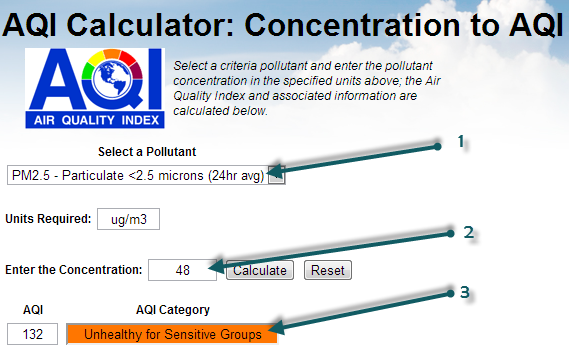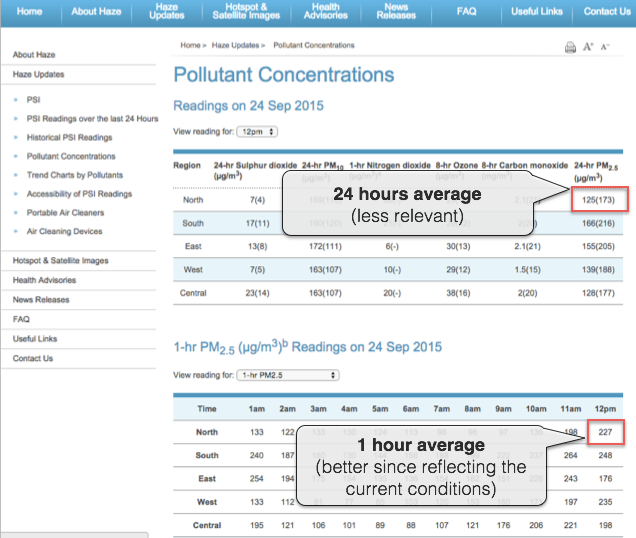In April 2014, the Singapore NEA has updated the PSI calculation to also include PM2.5. http://www.nea.gov.sg/anti-pollution-radiation-protection/air-pollution-control/psi
S nedavnim smogom u jugoistočnoj Aziji iz Indonezije koji utječe na Singapur i sada na Maleziju , dobili smo mnoga pitanja o tome zašto postoji razlika između podataka koji se mogu pročitati na web stranici Singapore NEA ( nea.gov.sg ) i projekta Svjetskog indeksa kvalitete zraka Singapur web stranica .
Na primjer, evo što se danas može pročitati na web stranici NEA:

Iz nekog povijesnog razloga, Singapur koristi PSI ( standardni indeks zagađivača ) za procjenu kvalitete zraka. Na gornjoj slici, broj 1 odgovara vrijednosti PM10 koja se koristi za procjenu PSI. Vrijednost 67(/59) može se očitati kao 67 μg/m3, što odgovara PSI od 59. PSI se procjenjuje kao maksimum pojedinačnog PSI za svaki od onečišćujućih tvari: PM 10 , SO 2 , NO 2 , O 3 (ozon) i CO 2 .
PSI(Singapore-North) = max( PSIPM10-based, ... PSIO3-based )= max (59, ..., 77) = 77
S tim u vezi, zanimljivo je da su u ovoj istoj tablici podaci o PM2,5 također navedeni u zadnjem stupcu (vidi 3). Ovi se podaci daju samo u μg/m3 (vidi 2) i ne postoji pretvorba u nešto poput PSI (tj. pretvorba mase PM2,5 u indeks onečišćenja ili kvalitete). Međutim, ova konverzija postoji i definirana je od strane Agencije za zaštitu okoliša SAD-a . Najlakši način za pretvorbu je korištenje online kalkulatora, dostupnog na airnow.gov :

If you select the PM2.5 (1), then enter the mass concentration of 48 (2), can click on Calculate, you will obtain the AQI of 132 (3). So, based on the PM2.5 AQI conversion, the PSI that is used for Singapore could be extended (let's call it PSI++) to also take into account the PM2.5 information. In which case, the PSI++ would be the maximum of the regular PSI (based on PM10 only) and the PM2.5 AQI:
PSI++ = max( PSI, AQIPM.25 ) = max( 77, 132 ) = 132
This PSI++, that is commonly referred as AQI (or Air Quality Index), is what is being used on the the World Air Quality Index project, for all the cities (provided PM2.5 is available for the city). And this explains why the values are different between the NEA website and the World Air Quality Index project.
Moreover, when doing the convertion, make sure you use the 1-hour reading for the PM2.5 concentration rather than the 24-hours averaged value, as shown on the below image:

http://www.haze.gov.sg/haze-updates/pollutant-concentrations/type/PM25-1Hr
If you want to know more about PM10 vs PM2.5, and especially why PM10 is still used, please check the faq entry about why is PM2.5 often higher than PM10? Is PM10 still a relevant measure?
--
For more information about specific countries or continent, please refer to those articles: Thailand and Malysia - India - China - Hong Kong / Canada (Air Quality Health Index) - South America - Australia - Quebec and Montreal - Singapore - Poland - Indonesia .
For information about the 24 hours averaging used or Ozone and Particulate Matter (PM2.5), please refer to those two articles: Ground Ozone Index - PM2.5 Instant Cast
